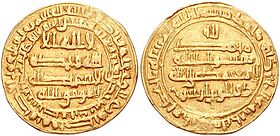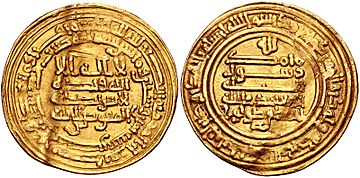- This page was last modified on 17 October 2025, at 10:18. Suggest an edit.
al-Mu'tamid facts for kids
This page is about the 9th-century Abbasid Caliph. For the 11th-century Abbadid king of Seville, see al-Mu'tamid ibn Abbad.
| al-Mu'tamid المعتمد |
|||||
|---|---|---|---|---|---|
| Caliph Commander of the Faithful |
|||||

Gold dinar of al-Mu'tamid, minted in 884/5, with the names of al-Muwaffaq and the latter's vizier, Sa'id ibn Makhlad (Dhu'l-Wizaratayn)
|
|||||
| 15th Caliph of the Abbasid Caliphate | |||||
| Reign | 16 June 870 — 14 October 892 | ||||
| Predecessor | al-Muhtadi | ||||
| Successor | al-Mu'tadid | ||||
| Born | c. 842 Samarra, Abbasid Caliphate |
||||
| Died | 14 October 892 (aged c. 50) Samarra, Abbasid Caliphate |
||||
| Burial | Samarra | ||||
| Consort |
|
||||
| Issue |
|
||||
|
|||||
| Dynasty | Abbasid | ||||
| Father | al-Mutawakkil | ||||
| Mother | Fityan | ||||
| Religion | Sunni Islam | ||||
Abu’l-ʿAbbās Aḥmad ibn Jaʿfar (Arabic: أبو العباس أحمد بن جعفر; around 842 – 14 October 892), known as al-Muʿtamid ʿalā ’llāh ('Dependent on God'), was the caliph of the Abbasid Caliphate from 870 to 892. His time as caliph marked the end of a chaotic period known as the "Anarchy at Samarra".
However, al-Mu'tamid was mostly a caliph in name only. Real power was held by his brother, al-Muwaffaq, who had the loyalty of the army. Al-Mu'tamid's power became even smaller after he tried to escape in 882. He was then kept under house arrest by his brother.
When al-Muwaffaq died in 891, some people tried to give power back to al-Mu'tamid. But al-Muwaffaq's son, al-Mu'tadid, quickly took over his father's role. When al-Mu'tamid passed away in 892, al-Mu'tadid became the new caliph.
Contents
Life of al-Mu'tamid
Al-Mu'tamid was the son of Caliph al-Mutawakkil (who ruled from 847 to 861). His mother was a slave girl from Kufa named Fityan. His full name was Ahmad ibn Abi Jaʿfar. He was also known as Abu'l-Abbas.
After the previous caliph, al-Muhtadi, was removed by Turkish military leaders, Ahmad was chosen as the next caliph. He was given the special name al-Muʿtamid ʿAlā ’llāh on June 16 or 19, 870. A few days later, al-Muhtadi was executed.
A New Era for the Caliphate
Al-Mu'tamid becoming caliph brought an end to a very troubled time. This period, called the "Anarchy at Samarra", had started in 861. During this time, the central government lost control over many parts of the Caliphate.
- In the west, Egypt was controlled by a strong Turkish soldier named Ahmad ibn Tulun. He also wanted to control Syria.
- In the east, Khurasan and other areas were taken over by the Saffarids.
- Many parts of the Arabian peninsula were also lost to local rulers.
- Even in Iraq, a large rebellion of enslaved people had started. This rebellion soon threatened the capital city, Baghdad.
Al-Mu'tamid's position was also weak from the inside. The powerful Turkish soldiers held the real power. His brother, Abu Ahmad Talha, was the main military leader. He was the link between the caliph and the Turkish army.
Al-Muwaffaq's Power
Al-Mu'tamid seemed to have little experience in politics. He also did not have a strong group of supporters. When the previous caliph was killed, al-Mu'tamid's brother, Abu Ahmad, quickly took control. He and another leader, Musa ibn Bugha, pushed al-Mu'tamid aside.
Al-Mu'tamid quickly became a caliph who only had the title, but no real power. This continued for the rest of his rule. Abu Ahmad was given control over most of the lands still under the Caliphate. These included western Arabia, southern Iraq, Baghdad, and Fars. To show his power, he took a special name, al-Muwaffaq bi-Allah.
Al-Mu'tamid still had the right to choose his own chief ministers (called viziers). But after 877, al-Muwaffaq's own secretary took over this role. Real power always stayed with al-Muwaffaq or his trusted people.
On July 20, 875, al-Mu'tamid officially planned for his son, Ja'far, to be the next caliph. Ja'far was given the name al-Mufawwad ila-llah. He was supposed to rule the western half of the Caliphate. Al-Muwaffaq was named the second in line and received the eastern provinces. However, al-Mufawwad never had any real power. Al-Muwaffaq continued to control all provinces through his trusted officers.
Al-Muwaffaq's power grew because the Caliphate faced many military threats. He commanded the loyalty of the army. In April 876, al-Muwaffaq defeated the Saffarids who tried to capture Baghdad. This victory saved the Caliphate from falling apart.
After this, the Abbasids focused on stopping the Zanj Revolt in the south. The Zanj rebels had taken over much of lower Iraq. They had also defeated the Abbasid troops many times. In 879, al-Muwaffaq's son, Abu'l-Abbas, took command against the Zanj. The next year, al-Muwaffaq himself joined the fight. The Abbasid forces pushed the Zanj back to their capital, Mukhtara, which fell in August 883.
Conflict with Ibn Tulun

Gold dinar, minted in Fustat in 881/2, in the name of al-Mu'tamid, al-Mufawwad, and the ruler of Egypt Ahmad ibn Tulun
At the same time, al-Muwaffaq also had to deal with Ahmad ibn Tulun. Ibn Tulun was the powerful ruler of Egypt. He and al-Muwaffaq had a disagreement in 875/6. This happened when a large amount of money was sent from Egypt to the central government.
Ibn Tulun sent more money to al-Mu'tamid than to al-Muwaffaq. He hoped to use the rivalry between the Caliph and his powerful brother. Al-Muwaffaq was angry because he felt he deserved most of the money for fighting the Zanj. He tried to send troops to Syria and Egypt, but the plan failed.
In 878, Ibn Tulun showed his support for al-Mu'tamid. He took the title "Servant of the Commander of the Faithful." With al-Mu'tamid's support, Ibn Tulun gained control over all of Syria and the border area with the Byzantine Empire.
In 881, Ibn Tulun even put his own name on coins. These coins also had the names of the Caliph and his son, al-Mufawwad. In late 882, a general from Ibn Tulun's army switched sides to the Abbasids. This caused trouble for Ibn Tulun in Syria.
Al-Mu'tamid saw this as a chance to escape from Samarra. He left with a small group of people, heading for Ibn Tulun's lands. Ibn Tulun was very excited, thinking he would gain control over the Caliph. However, al-Muwaffaq's people found out. The governor of Mosul caught al-Mu'tamid and his group at al-Haditha.
Al-Mu'tamid was brought back to Samarra in February 883. He was placed under house arrest. He was even moved to another city for a while so al-Muwaffaq could watch him closely. In March 884, the powerless Caliph was allowed to return to Samarra. He was forced to speak against Ibn Tulun. He also had to name someone else as the governor of Syria and Egypt.
Around 886/7, the Caliph gave the title of "king" to Ashot I, the ruler of Armenia. Although Ashot I still paid tribute to the Abbasid court, he and other Armenian princes were largely independent rulers.
The Rise of Al-Mu'tadid
In 889, al-Muwaffaq had a disagreement with his son, Abu'l-Abbas. The reasons are not clear, but Abu'l-Abbas was put in prison. Al-Muwaffaq spent the next two years fighting in western Iran.
By May 891, al-Muwaffaq was very ill and close to death. Some officials in Baghdad tried to keep Abu'l-Abbas in prison. They wanted power to go to al-Mu'tamid. So, they invited the Caliph and his son to the city.
However, this plan failed because Abu'l-Abbas was very popular with the soldiers and common people. The soldiers set him free. When al-Muwaffaq died on June 2, Abu'l-Abbas immediately took his father's place. Abu'l-Abbas took the name al-Mu'tadid bi-llah. He also took his father's place in the line of succession after the Caliph and al-Mufawwad.
The powerless al-Mufawwad was removed from his position on April 30, 892. When al-Mu'tamid died on October 14, 892, al-Mu'tadid became the new caliph.
See Also
- Abbasid Caliphate
- Anarchy at Samarra
- Al-Muwaffaq
- Ahmad ibn Tulun
Sources
- Bianquis, Thierry (1998). [Al-Mu'tamid at Google Books "Autonomous Egypt from Ibn Ṭūlūn to Kāfūr, 868–969"]. The Cambridge History of Egypt, Volume 1: Islamic Egypt, 640–1517. Cambridge: Cambridge University Press. pp. 86–119. ISBN 0-521-47137-0. Al-Mu'tamid at Google Books.
- "Armīniya, II. History 2. — Armenia under Arab domination". The Encyclopaedia of Islam, New Edition, Volume I: A–B. (1960). Leiden: E. J. Brill. 635–638. DOI:10.1163/1573-3912_islam_COM_0064.
- Bonner, Michael (2010). "The waning of empire, 861–945". In Robinson, Chase F.. The New Cambridge History of Islam, Volume 1: The Formation of the Islamic World, Sixth to Eleventh Centuries. Cambridge: Cambridge University Press. pp. 305–359. ISBN 978-0-521-83823-8.
- Bosworth, C. E. (1975). [Al-Mu'tamid at Google Books "The Ṭāhirids and Ṣaffārids"]. [Al-Mu'tamid at Google Books The Cambridge History of Iran, Volume 4: From the Arab Invasion to the Saljuqs]. Cambridge: Cambridge University Press. pp. 90–135. ISBN 0-521-20093-8. Al-Mu'tamid at Google Books.
- Fields, Philip M., ed. (1987). The History of al-Ṭabarī, Volume XXXVII: The ʿAbbāsid Recovery: The War Against the Zanj Ends, A.D. 879–893/A.H. 266–279. SUNY Series in Near Eastern Studies.. Albany, New York: State University of New York Press. ISBN 978-0-88706-054-0. https://books.google.com/books?id=igltYwUE764C.
- Hassan, Zaky M. (1960–2005). "Aḥmad b. Ṭūlūn". The Encyclopaedia of Islam, New Edition (12 vols.). Leiden: E. J. Brill. 278–279.
- Kennedy, Hugh N. (1993). "al-Muʿtamid ʿAlā ’llāh". The Encyclopaedia of Islam, New Edition, Volume VII: Mif–Naz. Leiden: E. J. Brill. 765–766.
- Kennedy, Hugh (2001). [Al-Mu'tamid at Google Books The Armies of the Caliphs: Military and Society in the Early Islamic State]. London and New York: Routledge. ISBN 0-415-25093-5. Al-Mu'tamid at Google Books.
- Kennedy, Hugh (2004). [Al-Mu'tamid at Google Books The Prophet and the Age of the Caliphates: The Islamic Near East from the 6th to the 11th Century] (Second ed.). Harlow: Longman. ISBN 978-0-582-40525-7. Al-Mu'tamid at Google Books.
- Mottahedeh, Roy (1975). [Al-Mu'tamid at Google Books "The ʿAbbāsid Caliphate in Iran"]. [Al-Mu'tamid at Google Books The Cambridge History of Iran, Volume 4: From the Arab Invasion to the Saljuqs]. Cambridge: Cambridge University Press. pp. 57–89. ISBN 0-521-20093-8. Al-Mu'tamid at Google Books.
- Waines, David, ed. (1992). [Al-Mu'tamid at Google Books The History of al-Ṭabarī, Volume XXXVI: The Revolt of the Zanj, A.D. 869–879/A.H. 255–265]. SUNY Series in Near Eastern Studies.. Albany, New York: State University of New York Press. ISBN 978-0-7914-0763-9. Al-Mu'tamid at Google Books.
|
Al-Mu'tamid
Born: 844 Died: 892 |
||
| Sunni Islam titles | ||
|---|---|---|
| Preceded by Al-Muhtadi |
Caliph of the Abbasid Caliphate 16/19 June 870 — 14 October 892 |
Succeeded by Al-Mu'tadid |


